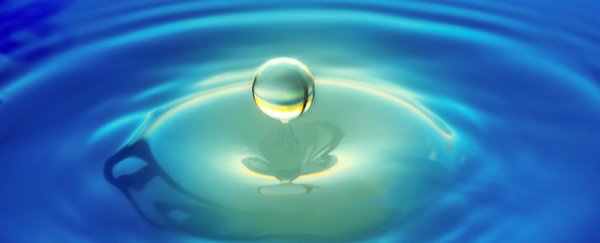Water is a weird molecule, and no matter how many strange things about it we discover, it seems like there are always more unexpected surprises waiting around the corner – even after centuries of researching it.
Case in point: in a new study, scientists in the US have discovered that in the right circumstances, water can spontaneously produce hydrogen peroxide – a quirk of basic chemistry, hiding in plain sight, which somehow eluded our notice until now.
"Water is one of the most commonly found materials, and it's been studied for years and years and you would think that there was nothing more to learn about this molecule," says chemist Richard Zare from Stanford University.
"But here's yet another surprise."
While the scientists observed the phenomenon taking place with pure water, not just any form of water will do.
According to the team, the spontaneous production of hydrogen peroxide can occur when water is atomised into microdroplets: microscopic droplets of water measuring just 1 micrometre to 20 micrometres in diameter.
One micrometre is just one thousandth of a millimetre, so we're talking incredibly tiny droplets here. At such an infinitesimal scale, the spontaneous formation of hydrogen peroxide appears to take place – even in the absence of almost anything else other than water.
"This process does not require any chemical reagent, catalyst, applied electric potential, or radiation," the researchers write in their new paper.
"Only pure water in the form of microdroplets in air is necessary for the appearance of hydrogen peroxide."
As it happens, the team discovered this surprising result by accident in previous research, investigating how gold nanoparticles and nanowires can be created using water droplets.
Those experiments revealed water microdroplets not only accelerate the synthesis of the gold nanostructures, but also cause their spontaneous formation.
In the new research, Zare's team ran a number of tests, including spraying pure water microdroplets onto a test strip that would only turn blue in the presence of hydrogen peroxide (it turned blue – see the video above).
Another experiment revealed that hydrogen peroxide production yield was inversely proportional to microdroplet size; in other words, smaller microdroplets produce higher concentrations of the molecule.
But why and how does this happen at all?
It's hard to know for sure, but the researchers speculate that spontaneous oxidation of water likely occurs due to a strong intrinsic electric field at the water−air interface of microdroplets, where an electric field generates hydroxyl radicals that recombine into hydrogen peroxide.
While it will take future research to test this hypothesis, the team says the production of hydrogen peroxide itself is unambiguous, and could lead to new and more environmentally sustainable ways of manufacturing this common chemical.
"We suggest that this discovery opens various innovative opportunities including green and inexpensive production of hydrogen peroxide, green chemical synthesis, safe cleaning, and food processing," the authors write.
For Zare himself – an influential prize-winning chemist who holds no less than 11 honorary doctorates – the discovery is as significant as it is surprising.
"I think it could be one of the most important things I've ever done," he says.
The findings are reported in PNAS.
